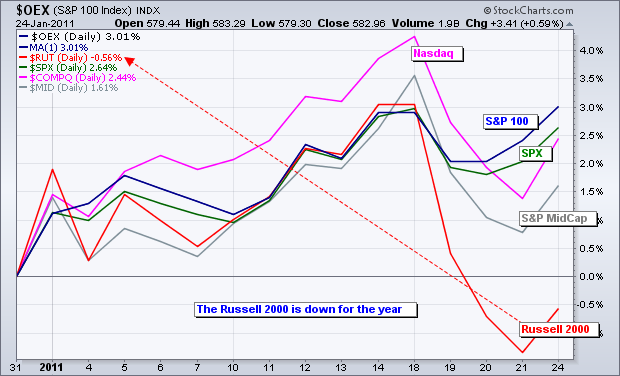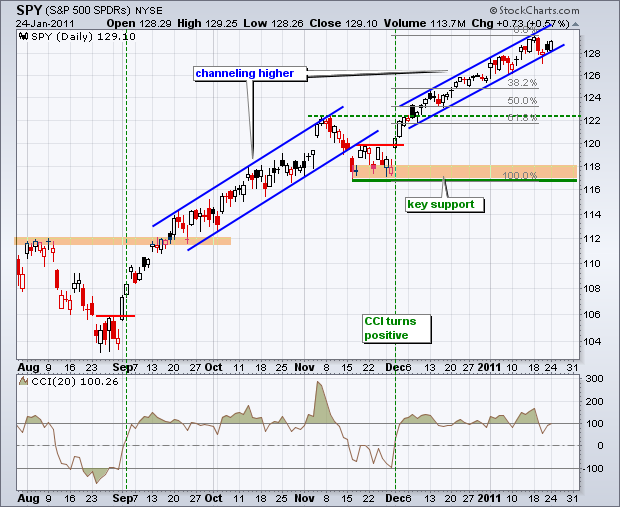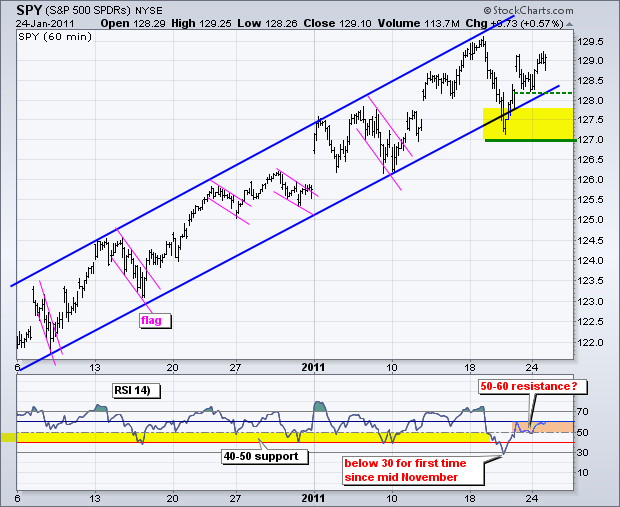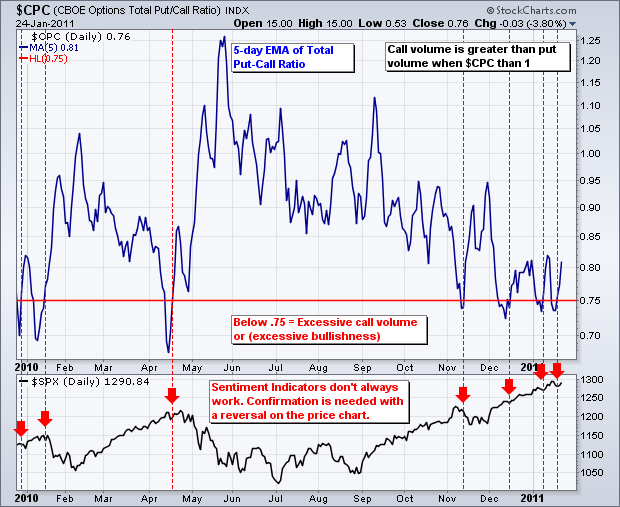Stocks were broadly higher on Monday as the Dow Industrials zoomed to a new 52-week high. The Russell 2000, S&P 500 and Nasdaq 100 were also up on the day, but did not record new 52-week highs. The Dow is leading. The rest are lagging. I remain concerned with relative weakness in small-caps, the consumer discretionary sector and the Dow Transports. In addition, the sentiment readings were excessively bullish in January as the CBOE Total Put/Call Ratio ($CPC) dipped to low levels twice this month. Sentiment surveys also showed a high percentage of bulls recently. These sentiment indicators and relative weakness indications are often a few weeks early. In other words, they are foreshadowing indicators the put us on alert for a possible trend change. We have yet, however, to see complete breakdowns on the price charts or with key short-term breadth indicators. Net Advances and Net Advancing Volume surged on the Nasdaq and NYSE yesterday to keep breadth in bull mode. Forecasters who look around-the-corner are already bearish. Trend-followers are still bullish and waiting for evidence of a trend reversal.

The daily chart analysis for SPY remains unchanged. The medium-term trend is up as SPY holds within a tight rising channel. A channel break would argue for a correction with first support marked by broken resistance around 122. This area also marks a 50-62% retracement of the December-January advance. CCI remains in positive territory to keep momentum bullish. A move into negative territory would signal that a correction is underway.

No change. The 60-minute chart provided the first signs of weakness since mid November as RSI broke below 30 and SPY pierced its channel trendline. This momentum indicator bounced back, but dips below 30 are more common in downtrends than uptrends. The problem, of course, is that the medium-term trend (daily chart) is clearly up. This makes a short-term downtrend a correction or counter-trend move. A short-term downtrend combined with a medium-term uptrend could result in a sideways movement or trading range. A big news week and conflicting trends could make this a good week to clean the garage.

It is a pretty big week news-wise. First, earnings season is in full swing with over 350 reports slated for this week (and next). Second, the Fed starts its two day meeting on Tuesday with its policy statement expected at 2:15PM on Wednesday. Third, there is the State of the Union speech on Tuesday night. Fourth, there will be a smattering of economic reports, including New Home Sales on Wednesday and Durable Goods on Thursday.
Key Economic Reports:
Tue - Jan 25 - 09:00 – FOMC Meeting Starts
Tue - Jan 25 - 09:00 - Case-Shiller Index
Tue - Jan 25 - 10:00 - Consumer Confidence
Wed - Jan 26 - 07:00 - MBA Mortgage Purchase Index
Wed - Jan 26 - 10:00 - New Home Sales
Wed - Jan 26 - 10:30 - Oil Inventories
Wed - Jan 26 - 14:15 - FOMC Rate Decision/Policy Statement
Thu - Jan 27 - 08:30 - Job Claims
Thu - Jan 27 - 08:30 - Durable Orders
Thu - Jan 27 - 10:00 - Pending Home Sales
Fri - Jan 28 - 08:30 - GDP Estimate
Fri - Jan 28 - 09:55 - Michigan Sentiment
Charts of Interest: Tuesday and Thursday in separate post.
-----------------------------------------------------------------------------
This commentary and charts-of-interest are designed to stimulate thinking. This analysis is not a recommendation to buy, sell, hold or sell short any security (stock ETF or otherwise). We all need to think for ourselves when it comes to trading our own accounts. First, it is the only way to really learn. Second, we are the only ones responsible for our decisions. Think of these charts as food for further analysis. Before making a trade, it is important to have a plan. Plan the trade and trade the plan. Among other things, this includes setting a trigger level, a target area and a stop-loss level. It is also important to plan for three possible price movements: advance, decline or sideways. Have a plan for all three scenarios BEFORE making the trade. Consider possible holding times. And finally, look at overall market conditions and sector/industry performance.







